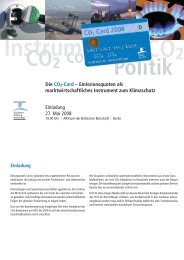Impulses for Growth and Employment through Profitable Savings in ...
Impulses for Growth and Employment through Profitable Savings in ...
Impulses for Growth and Employment through Profitable Savings in ...
You also want an ePaper? Increase the reach of your titles
YUMPU automatically turns print PDFs into web optimized ePapers that Google loves.
Besides the level of <strong>in</strong>put-output computation<br />
that is profoundly structured <strong>in</strong> 59 production<br />
or economic sectors, the model <strong>for</strong><br />
the computation of the national economic<br />
variables conta<strong>in</strong>s the account system of<br />
the national economic accounts of the<br />
Federal Republic of Germany. This system<br />
conta<strong>in</strong>s all <strong>in</strong>come redistribution <strong>in</strong>clud<strong>in</strong>g<br />
social security <strong>and</strong> taxation between the<br />
government, private households <strong>and</strong> bus<strong>in</strong>ess<br />
<strong>and</strong> thus enables the computation of<br />
available <strong>in</strong>comes which themselves are<br />
important determ<strong>in</strong>ants of f<strong>in</strong>al dem<strong>and</strong>.<br />
Moreover, the f<strong>in</strong>anc<strong>in</strong>g balances of <strong>in</strong>stitutional<br />
transactors are determ<strong>in</strong>ed. This<br />
means that governmental budget restrictions<br />
are also <strong>in</strong>cluded <strong>in</strong> the model. The<br />
complete fiscal policy is there<strong>for</strong>e also<br />
endogenously embedded <strong>in</strong> the system.<br />
Monetary policy, <strong>in</strong> as much as it <strong>in</strong>fluences<br />
<strong>in</strong>terest levels, is also endogenous.<br />
Scenarios Exam<strong>in</strong>ed<br />
The period 2004-2015 was chosen <strong>for</strong> the<br />
appraisal as this is an appropriate time l<strong>in</strong>e<br />
<strong>for</strong> a political programme that seeks to<br />
change efficiency structures on a wide<br />
scale <strong>in</strong> the economy at large. The effects<br />
of profitable dematerialization are exam<strong>in</strong>ed<br />
by us<strong>in</strong>g the values achieved <strong>in</strong> 2015<br />
on the basis of different scenarios <strong>and</strong><br />
compar<strong>in</strong>g them to the zero variant (endogenous<br />
extrapolation of the status quo<br />
<strong>in</strong> the model):<br />
• In Scenario I “Imperfect Markets” profitable<br />
dematerialization takes place<br />
with<strong>in</strong> the environment of present-day<br />
wage <strong>and</strong> price <strong>for</strong>mation <strong>in</strong> Germany.<br />
• In Scenario II “Wage Competition” it is<br />
assumed – <strong>in</strong> variance to Scenario I –<br />
that productivity ga<strong>in</strong>s <strong>through</strong> dematerialization<br />
do not lead to higher wages<br />
but <strong>in</strong>stead correspond to those of the<br />
base scenario.<br />
• In Scenario III “Price Competition” we<br />
assume – <strong>in</strong> variance to Scenario I –<br />
that competitive pressure <strong>for</strong>ces companies<br />
to pass on nationally achieved<br />
productivity ga<strong>in</strong>s to consumers <strong>in</strong> the<br />
<strong>for</strong>m of lower prices. Wage <strong>for</strong>mation<br />
corresponds to that <strong>in</strong> Scenario I.<br />
Scenarios II <strong>and</strong> III do not confer with present-day<br />
economic practice but po<strong>in</strong>t to<br />
the numerous welfare ga<strong>in</strong>s that can be<br />
achieved on the labour <strong>and</strong> product markets<br />
on the basis of more complete competition.<br />
Common Assumptions<br />
Across all Scenarios<br />
Simplified assumptions are necessary <strong>for</strong><br />
depict<strong>in</strong>g the scenarios <strong>in</strong> INFORGE. In all<br />
scenarios, profitable dematerialization is<br />
depicted <strong>through</strong> a l<strong>in</strong>ear reduction of material<br />
costs per unit of production <strong>in</strong> the<br />
manufactur<strong>in</strong>g sector <strong>and</strong> <strong>in</strong> public adm<strong>in</strong>istration<br />
by 20% across the study’s time<br />
l<strong>in</strong>e. In several ways, this is a conservative<br />
assumption:<br />
• Company practice shows double as<br />
much potential (20% of manufactur<strong>in</strong>g<br />
costs <strong>in</strong>stead of 20% of material<br />
costs).<br />
• The scenarios limit the cost effects to<br />
production <strong>in</strong> the manufactur<strong>in</strong>g sector<br />
<strong>and</strong> <strong>in</strong> public adm<strong>in</strong>istration. This<br />
means that the economic sectors with<br />
the highest dematerialization potentials<br />
are addressed but that a political programme<br />
aimed at profitable<br />
dematerialization will have effects on<br />
other sectors too <strong>through</strong> respectively<br />
optimised products <strong>and</strong> know-how<br />
• transfer. The development of new products is<br />
not explicitly taken <strong>in</strong>to account <strong>in</strong> the<br />
scenarios. In reality, however, a strong<br />
surge toward the dematerialization of<br />
production <strong>and</strong> product use will not<br />
only reduce costs but also create new<br />
products. Cellular phones are a case <strong>in</strong><br />
po<strong>in</strong>t which only became a mass market<br />
after m<strong>in</strong>iaturisation with concomitant<br />
cost reductions <strong>and</strong> easier usability<br />
occurred.<br />
As such efficiency ga<strong>in</strong>s do not simply fall<br />
from the heavens but require <strong>in</strong>novation<br />
<strong>and</strong> <strong>in</strong>vestment by companies annual sav<strong>in</strong>gs<br />
need to be juxtaposed with one-time<br />
expenditures 33% of which consist of dem<strong>and</strong><br />
<strong>for</strong> services close to the company<br />
<strong>and</strong> 66% of which consist of fixed <strong>in</strong>vestment.<br />
With respect to material cost reduction<br />
(50% of total <strong>in</strong>dustrial costs) this onetime<br />
expenditure amounts to a simple annual<br />
sav<strong>in</strong>g while with respect to energy<br />
cost reduction (2% of <strong>in</strong>dustrial costs) it<br />
6




